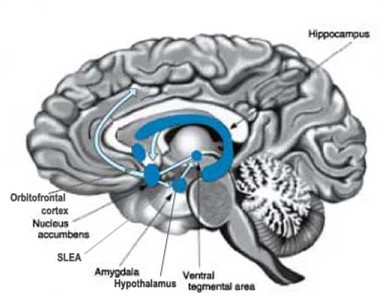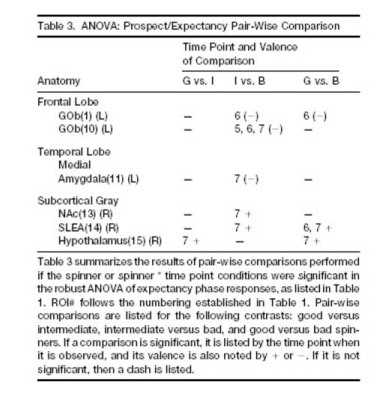The WAGER, 8(33) – Biology, Addiction, and Gambling: Money Makes the Brain Go Round
Some behaviors, such as sex, eating, or touching unconditionally invoke an emotional reaction in humans. Receiving money also can serve to stimulate motivational forces. Experiments on animals show that physiological incentives activate discrete areas of the brain known to be involved in the dopaminergic reward pathway (Hollerman & Schultz, 1998; Mora, Mogenson, & Rolls, 1977; Ono, Nakamura, Nishijo, & Fukuda, 1986; Schoenbaum, Chiba, & Gallagher, 2000). By examining activation of the reward pathway, researchers hope to determine if money elicits a similar response as behaviors like sex, eating, and touching. Breiter, Aharon et al. (2001) tested subjects to explore the human brain’s reward system reaction to money-based gambling situations.
Twenty male, right-handed subjects played a game of chance while researchers, using fMRI technology, measured changes in blood levels, also known as hemodynamic levels, in several areas of the brain. Hemodynamic changes are important because an increase in blood flow to an area of the brain indicates that area is being activated in response to the presented stimuli. Shown in Figure 1 are the areas of the brain hypothesized to be activated during games of chance, including the ventral tegmentum, orbitofrontal cortex, nucleus accumbens, hypothalamus, amygdala, and sublenticular extended amygdale (SLEA) of the basal forebrain. To determine if these areas are involved in gambling, researchers measured hemodynamic levels while conducting the following experiment.
Figure 1. Relevant areas of the brain (some elements of the dopaminergic system)
The experiment consisted of two trial segments: a “prospect” phase, which monitored a subject’s attention to the prospect of gaining or losing money (i.e., anticipation of a potentially favorable or unfavorable event), and an “outcome” phase, which monitored a subject’s reaction to the amount of money actually given or taken (i.e. reaction to a favorable or unfavorable event). This WAGER focuses on results from the first segment, the prospect phase. Subjects viewed a projection of either a fixation point, resembling a large asterisk, or one of three types of spinners. The fixation point was used to establish a baseline hemodynamic level. The gain and loss structures of the spinners were such that spinners were “good” or favorable for gaining money, “intermediate” or moderately favorable for gaining money, and “bad” or unfavorable for gaining money (Figure 2). As the trial began, a static spinner or a fixation point appeared for .5 seconds. An arrow appeared on the spinner after the .5 seconds and then spun for 5.5 seconds, during which investigators measured the hemodynamic levels in the brain. After the total 6 seconds, the arrow came to rest on one of the slices of the spinner, indicating how much money the subject gained or lost. The experiment consisted of 8 runs; each run contained 19 trials and concluded with all subjects earning the same sum of money ($128.50).
Figure 2. Three types of spinners and a fixation point
Throughout the experiment, a broad range of brain areas were activated. Also, results revealed a differentiation between hemispheric responses. The right hemisphere predominantly responded to the prospect of gains and the left hemisphere predominantly responded to the prospect of losses. As illustrated in Figure 3, the nucleus accumbens, SLEA, and hypothalamus showed significantly greater activation to spinners with more favorable possible outcomes (e.g. intermediate, and good) compared to spinners with less favorable possible outcomes (e.g. bad); the amygdala and 2 areas of the orbitofrontal cortex showed opposite responses, producing greater activation for unfavorable compared with more favorable outcomes. This suggests that activations of the nucleus accumbens, SLEA and hypothalamus tend to be associated with positive results such as winning money; whereas activations in the amygdala and orbitofrontal cortex tend to be associated with negative results such as losing money.
Figure 3. Comparing brain activations to two different types of spinners.
Subjects’ awareness of their overall earnings throughout the experiment might have influenced their hemodynamic responses to individual sequences. Of twelve subjects, nine guessed their earnings at 47% of the actual amount or less. Yet, a quarter of subjects guessed at very high accuracies, 99.6%, 86% and 76% respectively. The impact of participants’ varying awareness is not known. Another limitation is that, because all subjects were right-handed males, results exhibiting localization of responses to particular hemispheres of the brain might not generalize to a larger population of mixed gender, mixed right and left hand dominant individuals. Although these sample characteristics may have been chosen for controls, localization of activation, particularly the brain hemisphere differences, cannot be generalized to left handed subjects or females.
Despite limitations, this research helps to classify areas of the brain that might be involved in gambling and other potentially stimulating or rewarding experiences. Hemodynamic responses in three dopaminergic terminals, the nucleus accumbens, the hypothalamus, and the SLEA, showed similar responses in monkeys anticipating rewards (see WAGER 8(31)). Moreover, activations in the brain regions overlap previous reward pathway research on tactile, gustatory, and drug-induced euphoria stimuli. Because similar areas are stimulated in response to gambling situations as in other situations, general pharmacological treatments might eventually serve to target these dopaminergic systems, treating addictive disorders of all kinds. This research sets the stage for understanding similarities among various types of motivating factors and, for example, linking cocaine addiction to non-chemical based disorders such as pathological gambling. This supports a more universal definition of addictive disorders.
Comments on this article can be addressed to Michael V. Stanton
References
Breiter, H. C., Aharon, I., Kahneman, D., Dale, A., & Shizgal, P. (2001). Functional imaging of neural responses to expectancy and experience of monetary gains and losses. Neuron, 30, 619-639.
Hollerman, J. R., & Schultz, W. (1998). Dopamine neurons report an error in the temporal prediction of reward during learning. Nature neuroscience, 1(4), 304
309.
Mora, F., Mogenson, G. J., & Rolls, E. T. (1977). Activity of neurons in the region of the substantia nigra during feeding in the monkey. Brain Research., 133(2), 267-276.
Ono, T., Nakamura, K., Nishijo, H., & Fukuda, M. (1986). Hypothalamic neuron involvement in integration of reward, aversion, and cue signals. Journal of Neurophysiology., 56(1), 63-79.
Schoenbaum, G., Chiba, A. A., & Gallagher, M. (2000). Changes in functional connectivity in orbitofrontal cortex and basolateral amygdala during learning and reversal training. Journal of Neuroscience., 20(13), 5179-5189.
The WAGER is a public education project of the Division on Addictions at Harvard Medical School. It is funded, in part, by the National Center for Responsible Gaming, the Massachusetts Department of Public Health, the Substance Abuse and Mental Health Services Administration, and the Center for Substance Abuse Treatment.


